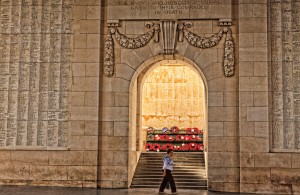Wanting to explore Flanders’ WW1 poppy fields and old battlegrounds? I tapped in the GPS coordinates for Dover – just a stone throw from London only 82 miles away. In Dover I took a ferry which deposited me across the English Channel in France’s Calais 90 minutes later. I planned to explore the territories where The Great War had been fought and to see the appalling conditions in which the soldiers lived and the immaculate cemeteries where many were laid to rest.
Just 45 minutes from Calais, in southern Flanders, is the town of Ypres (pronounced Eeper), a name forever linked with the martyrdom of the British Army during WW1.

Ypres is also known as the site of three major battles of the First World War– the most famous being the five-month Battle of Passchendaele in 1917. I met an expert on the subject at De Oude Kaasmakerij in Passendale. Freddy Declerck, an amiable fellow and Chairman of the Passchendaele Society (Lt Cdr Belgian Navy, retired). He knew much about the Great War and of the Ypres Salient battlefields in particular.
Over a Westmalle Trappist beer and some of the Belgium’s finest cheeses he told that here, barely a few kilometers outside of Ypres city center, that this particular battlefield had claimed the lives of more than 500,000 soldiers. The beautifully manicured Passendale countryside we were looking across held the bodies of more than 50,000 yet to be found.
“During the Great War,” Declerck said, “the Ypres Salient was an area of Allied (British and Belgian) held land surrounded on three sides by the German front line. It formed the northern-most section of the Western Front. Holding Ypres was vital for the Allies in their bid to prevent the Germans gaining control of all the Channel ports and Great Britain, just a few miles across the channel. As a result, the city became the focus of several major battles in the Salient and was subjected to continuous bombardment by German artillery for most of the war. By 1918, little remained of the town but shattered ruins surrounded by muddy shell-pocked fields.”
He looked to the horizon, gulping back emotions. “When counting the cost of human lives,” Declerck said, “this must surely be the most valuable piece of real estate in the world as near 250,000 British soldiers were lost trying to capture the ruined village of Passchendaele and the few kilometers of shell blasted mud around it.”
We visited numerous WW1 sites, as well as the Passchendaele Memorial Museum, for a personal trench experience. Although there are around 150 Commonwealth war cemeteries in the Ypres Salient region, emotionally I could only cope with seeing three. We began at the with the Tyne Cot Cemetery, with nearly 12,000 graves, it is the largest British war cemetery in the world.
During WW1, Poperinge was part of unoccupied Belgium. Immediately behind the front line, we found the soberly beautiful Lijssenthoek Military Cemetery, the largest WW1 hospital cemetery. Here too was the simple Germany military cemetery of Langemark. The sculptures of four bronze soldiers seemed to reflect the haunting sorrow of +44,000 soldiers buried there– most in mass graves.
We stopped off at Café La Poupée, a popular haunt amongst WW1 officers who all fell for the charms of the proprietor’s beautiful red-head daughter, Ginger. Over a St. Bernardus Abbey beer Declerck spoke of the nearby Talbot House.
“In 1915, army chaplain Tuby Clayton and Neville Talbot opened the famous wartime Club, Talbot House. Here soldiers of all rank came to relax. Now it’s a historic building open to the public, complete with war-time relics and artifacts. It still offers inexpensive war-time accommodations.”
My sensibilities now overdosed on senseless death, we returned to Ypres. Declerck reminded me that this was a city reduced to rubble during the war then fittingly rebuilt using German repatriation funds.
We lunched on the terrace of De Waterpoort, devouring moules and frites whilst discussing the city’s numerous Renaissance and Gothic structures. The impressive Cloth Hall Belfry and Town Hall, with its row of pointed arched-crossed windows, demanded a visit. We visited Saint-Martin’s Cathedral where Count Robert of Bethune, the Lion of Flanders, is buried and Saint-George’s Memorial Church, which holds individual memories of WW1.
Later I checked into Ypres’ Main Street Hotel, a luxury six-bed boutique hotel that merges quirky with bespoke and antique. Decorated with crystal, silk, and stained glass Ypres’ Main Street Hotel offers the best Flemish champagne breakfast you could imagine.
Over a welcome drink (and chocolate cake) my hostess, Carine Declercq, suggested a visit to the Menin Gate. “Amongst the most famous of all Ypres sites is the Menin Gate monument which displays the names of near 55,000 soldiers missing in action. Every evening since 1928 at precisely 8pm, the Last Post is sounded to commemorate the fallen.” It truly is an emotional experience and a must-do for all war historians.
Sidebars
• Main Street Hotel, Rijselstraat 136, B-8900 Ypres, Tel +32 57 469633, www.mainstreet-hotel.be
• Café La Poupee, Grote Markt 16, Poperinge, Tel +32 57 333008
• Talbot House, Gasthuisstraat 43, 8970 Poperinge, Tel +32 57 333228 www.talbothouse.be
• De Oude Kaasmakerij, ‘s Graventafelstraat 48 a, 8980 Passendale, +32 51 777005, www.deoudekaasmakerij.be
• Memorial Museum Passchendaele 1917, Ieperstraat 7, 8980 Zonnebeke, +32 51 770441, www.passchendaele.be
• De Waterpoort Restaurant, Bruges Weg 43, Ypres, Tel +32 57 205452 www.waterpoort.be
• Trappist beer tasting “In de vrede” Cafe, Donkerstraat 13, 8640 Westvleteren, Tel: +32 57 400377 www.indevrede.be
• Les Halles Marktcafe, Grote Markt, Ypres, Tel: +32 57 365563 www.marktcafe-leshalles.be
• A three-day P&O Ferries crossing costs £39 return for a car and passengers www.poferries.com. Access to the Club Lounge is £12 per person.
• Flanders Tourism www.visitflanders.com

